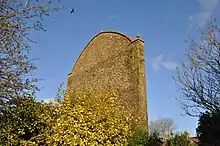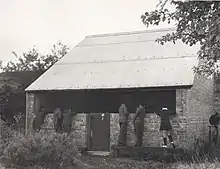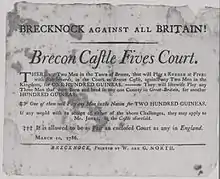Fives
Fives is an English sport believed to derive from the same origins as many racquet sports. In fives, a ball is propelled against the walls of a 3- or 4-sided special court, using a gloved or bare hand as though it were a racquet, similar to hand-pelota.


Background

The Concise Oxford Dictionary (1925) describes fives as a ball game played with hands or bat in court with two, three or four walls.[1] The name may be derived from the slang expression "a bunch of fives" (meaning a fist). The game has also been known as hand-tennis and historically was often played between the buttresses of church buildings in England.[2] There are links between Fives and the Irish, Welsh and North American handball[2] games. In recent years, British clubs began to establish ties with clubs in those countries.
Fives is not the same as Long Fives, which is played in a real tennis court.[3]
Types
There are two main types of fives, Rugby Fives and Eton Fives.[2] A precursor to Rugby Fives is Warminster (or Wessex) Fives; another variant of Wessex fives is Winchester Fives, although there are only about nine places in the UK where this is still played.[4]
Most schools where fives is played have only one type of court but three schools have historically had both Eton and Rugby courts – Cheltenham, Dover and Marlborough. Cheltenham has only Rugby courts and Dover has two unrestored Eton courts; Marlborough has four Rugby and two Eton courts, all in good condition. Malvern College also has 3 Winchester fives courts all in good condition.
Eton Fives
Eton Fives, invented by Eton boys in 1877,[5] is played competitively as a doubles game. In Eton Fives the ball is slightly softer and lighter than other versions of the game and the gloves are fairly thin.
The Eton Fives court is modelled on part of Eton College's Chapel[2] and is enclosed on three sides and open at the back. It has a more complex variation and some specific court features or "hazards". A small step splits the court into upper and lower sections, and sloping ledges run horizontally across the walls, one of which forms the "line". There is a large obstruction, known as a 'buttress', or a 'pepper' to fives players, on the left-hand side of the court in line with the step. At the bottom of the buttress is the 'box' or 'pepper pot'.[2] The step extends approximately 80 cm into the court and is around 15 cm high. The first courts at Eton were built in 1840, and subsequently at a multitude of other locations, and the Laws for Eton Fives were first published in 1931.
The first Oxford-Cambridge Varsity Match was played in 1928, with a Ladies' Varsity Match following in 2007.[6]
The Eton Fives Championships changes location annually between the fives courts at Shrewsbury School and the courts at Eton.
Rugby Fives
Rugby Fives is said to owe its creation to the Headmaster Thomas Arnold who had first played Fives when a pupil at Lord Weymouth School, now Warminster School.
Rugby Fives, developed at Rugby School, is played in a four wall court (quite similar to a squash court). The four walls and floor are uniform and contain no hazards such as in Eton Fives. The front wall has a height of fifteen feet, sloping down about halfway along to four feet ten inches at the back. Rugby Fives is played as both a singles and a doubles game. The balls used in Rugby and Winchester Fives are fairly hard and hence the gloves worn are thicker than those used in Eton Fives.
Rugby Fives has had an official varsity match between Oxford and Cambridge annually since 1925.
Warminster Fives
The game of Warminster Fives, based on Wessex Fives, is thought to have been played from as early as 1787 at Lord Weymouth School, now Warminster School. An 1860 Warminster Fives Court still exists at Warminster School and was in regular use until the late 1950s. The game is not as well known as other versions, is rarely played in the area and the fine details of the game are probably lost. The Warminster Fives Rules are recorded in many locations including the Eton Fives Website.
Winchester Fives
Winchester Fives is a variation of Wessex fives, differing in the addition of a buttress (a thin layer of concrete reaching to the top of the court on the left-hand wall) much smaller than the one used in Eton Fives. The courts at Winchester and Radley ("proper" Winchester courts) have a 11-foot-high (3.4 m) back wall which further differentiates the courts from the Rugby variety. In several of these courts the buttresses have been filled in to create a Rugby court, since the Rugby form has become more universally recognised.
Clifton Fives
At Clifton College the court has a half-height back wall and if the ball bounces out of the back of the court, a 'let' is played.
St John's Fives
This version of the game is played at St John's School in Leatherhead. The St John's version is very similar to the Eton version but does not include the step between the front and the back sections of the court. In 2011 the courts at St John's underwent an upgrade.
Gissop's Fives
Played at the St Gissop School, West Sussex, this version is similar to Eton Fives except that a beveled stone 'balustrade' features three feet and three inches above the floor of the tangential wall of the court. The game was supposedly invented by alumnus George Henry Steering, who excelled at the game.
Rossall Fives
Played at Rossall school, it can most easily be described as a mix between Eton and Rugby Fives. With a small buttress, no back walls and a low ledge it can be a game that both Rugby Fives players and Eton Fives players can play on together on an almost level setting.
Players
Fives is a small sport played by groups and enthusiasts numbering perhaps 4,000 active adult players in the United Kingdom and there are a number of Old Boys' and university clubs which tend to be concentrated around the South East. There are other clubs around the country including Midlands clubs such as Bedford, Birmingham, Wolverhampton, Rugby, Repton and Shrewsbury.
A similar number play in schools. About forty schools are affiliated to the Eton Fives Association (the governing body of the Eton Fives variation) and compete in many tournaments and championship events throughout the year.
Traditionally, this was a pub game in the English county of Somerset.[7]
There are some well-established clubs overseas, such as the Zuoz Fives Club in Zurich, Switzerland,[8] and the game is also vigorously pursued in Nigeria where it is played by a cross-section of the population, especially in the north of the country.[9][10][11] The game was introduced to Nigeria by an Old Etonian teacher, J. S. Hogden, who was working in the northern towns of Katsina and Birnin Kebbi in 1928. It is generally played using a tennis ball in the country after Hogden realised that the traditional harder ball "took chunks out of the mud walls of the courts".[11] A tour of northern Nigeria was carried out by players from the Eton Fives Association in 1965.[12]
The Rugby Fives Association (the governing body of Rugby Fives, founded in 1927) has affiliations from over forty schools and thirty-two clubs, from Edinburgh to Tavistock, and there are also a number of clubs overseas, for example in South Africa and the United States.
Australia and New Zealand
Although almost unknown today, Fives was played in schools and universities in Australia in the nineteenth century. A court was opened at The Hutchins School in Hobart in November 1877,[13] The court was described as "the only one, we believe, in the colony", and its dimensions as: "Length of floor, 21 ft.; height and width of court 14 ft. each. The court will be an open one, with a flagged floor, the walls will be built of brick, and cemented on the inside."[14]
The erection of a Fives court on the Recreation Ground of the University of Melbourne is noted in the Council minutes of Trinity College in 1873,[15] and there were newspaper reports of an "annual tournament in connexion [sic.] with the University Fives Club" in 1881, when Professor Herbert Strong acted as judge.[16] A double-handed tournament and a single-handed handicap tournament were played there in August 1883.[17]
Fives is played in some secondary schools in New Zealand, for example Nelson College, New Zealand's oldest state school.[18] Courts in New Zealand commonly have three walls, with no back wall.
Early match
The first match on record between schools was when an Eton pair played at Harrow in 1885 (F. Thomas and C. Barclay of Eton beat E.M. Butler and B. R. Warren of Harrow).
Today
Although the image of Fives has been dominated by well-known public schools, courts do exist at state schools, and in recent years many of these have been brought into full use. The advantages of economy of space and low playing costs (ball and gloves) make it an attractive sport for schools.[5] Fives continues to develop in England and has started to attract interest from the wider community.[19] In the United States the only known Fives courts are at Groton School and the Union Boat Club in Massachusetts since the courts at St. Mark's School were recently removed; a Fives Court was also built into the A.D. Final Club at Harvard in 1899.
There are also numerous championships, notably the (doubles) Eton Fives Kinnaird Cup and the Rugby Fives Open Singles championship (The Jesters' Cup) and Open Doubles championship (The Cyriax Cup). There are many other Rugby Fives Tournaments. A very special Eton Fives event is the Engadin Challenge Cup played in the Alps at an altitude of 5400 ft.
References
- The Concise Oxford Dictionary. Clarendon Press. 1925.
- Chisholm, Hugh, ed. (1911). . Encyclopædia Britannica. 10 (11th ed.). Cambridge University Press. p. 450.
- Chisholm, Hugh, ed. (1911). . Encyclopædia Britannica. 16 (11th ed.). Cambridge University Press. p. 980.
- "Where you can play".
- de Quetteville, Harry (11 April 2013). "Eton Fives becomes a state school hit". The Daily Telegraph. London.
- "Cambridge University Eton Fives Club". Retrieved 17 March 2015.
- Daniel, Peter (2019). A guide to the industrial archaeology of Somerset. Association for Industrial Archaeology. ISBN 978-1-9161764-0-9.
- Zuoz Fives Club Zürich, Eton Fives Association. Retrieved 2017-06-23.
- Brock J (2011) Eton's ancient game thrives in Nigeria, Reuters, 2011-06-28. Retrieved 2017-06-23.
- 'Nigeria loves Eton fives', Al Jazeera, 2011-06-28. Retrieved 2017-06-23.
- Kano GP (2013) Gentlemen in northern Nigeria, The Economist, 2013-12-05. Retrieved 2017-06-23.
- A trip down memory lane - the EFA tour of Nigeria in 1965, Eton Fives Association. Retrieved 2017-06-23.
- "Hutchins' School Fives Court", The Mercury [Hobart], 24 Nov. 1877, p. 2.
- "Laying the Foundation Stone", The Mercury [Hobart], 24 Sep. 1877, p. 2.
- Minutes, Trinity College Council, 30 May 1873, vol. 1., p. 18.
- "Fives", The Argus, 9 July 1881, p. 8.
- "University Fives Club", The Argus, 18 Aug. 1883, p. 10.
- "Nelson College, New Zealand". Retrieved 17 March 2015.
- Randall, Charles (2005-10-19). "The Daily Telegraph Article". London. Retrieved 2008-03-21.